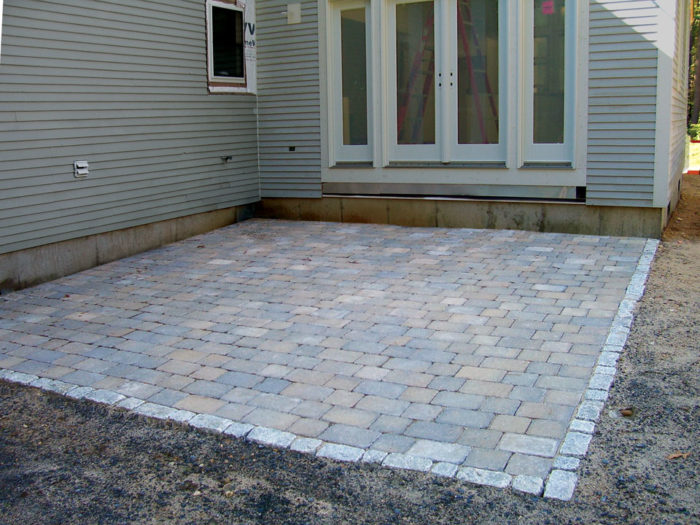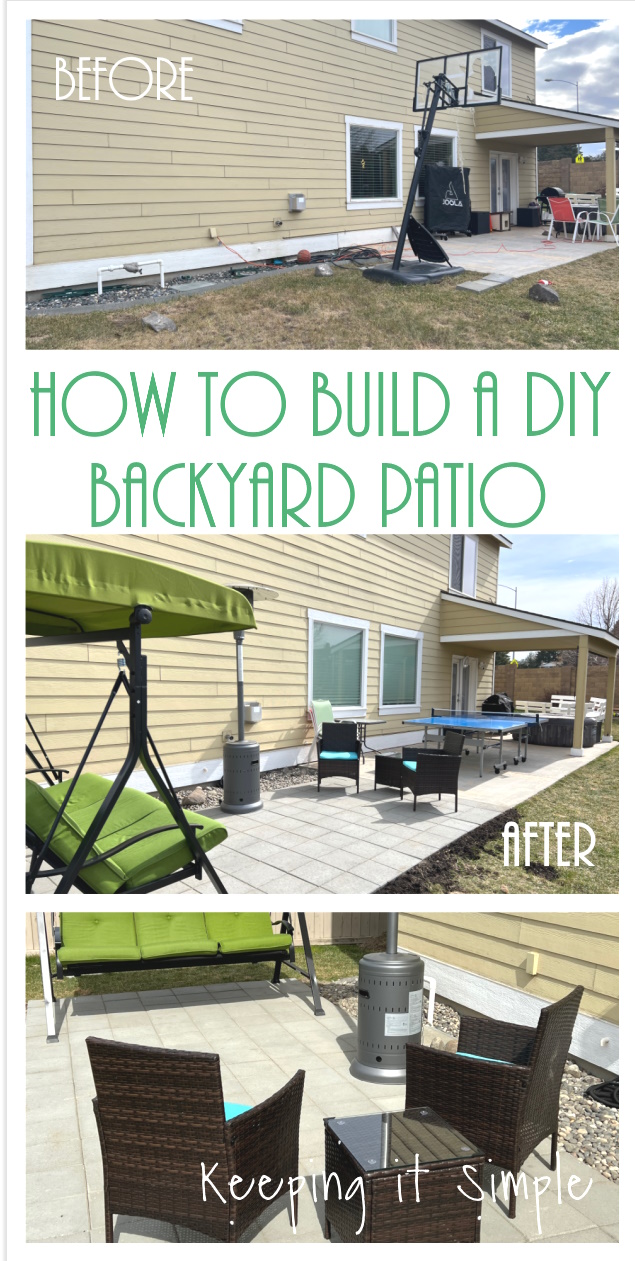To make a backyard patio, first, choose a location and clear the area of debris. Then, lay a solid foundation using gravel or sand.
Creating a backyard patio can transform your outdoor space into a functional and inviting area. Start by selecting the perfect spot that gets ample sunlight and fits your lifestyle needs. Clear the chosen area of any debris, plants, or obstacles.
Next, lay a foundation using gravel or sand to ensure proper drainage and stability. Choose patio materials like pavers, concrete, or natural stone that complement your home’s aesthetics. Arrange the materials in your desired pattern, ensuring they are level. Finally, add finishing touches such as outdoor furniture, lighting, and plants to create a cozy and welcoming atmosphere. Enjoy your new backyard patio for relaxation and entertaining.

Credit: therosetable.com
Introduction To Backyard Patio Creation
Creating a backyard patio transforms your outdoor space. You can enjoy nature, host gatherings, and relax. A well-designed patio adds value to your home. It provides a functional and aesthetic enhancement to your backyard.
Benefits Of Having A Patio
- Increased Home Value: A patio boosts your property’s market appeal.
- Outdoor Entertainment: Host parties and family gatherings with ease.
- Additional Living Space: Extend your living area into the outdoors.
- Relaxation Spot: Create a serene space to unwind and relax.
- Low Maintenance: Patios are easy to clean and maintain.
Choosing The Right Location
Choosing the right location for your patio is crucial. The location should be accessible and complement your home.
| Factor | Description |
|---|---|
| Sunlight | Consider areas with optimal sunlight or shade. |
| View | Choose a spot with a pleasant view of your garden. |
| Privacy | Select a location that offers privacy from neighbors. |
| Accessibility | Ensure the patio is easily accessible from your house. |
By considering these factors, you create a patio that enhances your outdoor experience. Plan carefully to get the most out of your backyard space.
Designing Your Patio Space
Creating a beautiful backyard patio starts with thoughtful design. The right design makes your space functional and appealing. Focus on patio size, shape, materials, and style. These factors ensure your patio suits your needs and enhances your home.
Patio Size And Shape Considerations
First, think about how you will use your patio. Do you plan to host large gatherings or prefer intimate family dinners? Your patio size should reflect your primary activities.
Measure your backyard to determine the available space. Make sure to leave enough room for walking and gardening. A larger patio may accommodate more furniture and features, but a smaller one can feel cozy and inviting.
Consider the shape of your patio too. Rectangular patios are traditional and functional. Circular or free-form shapes add a unique touch. The shape should complement your home’s architecture and landscaping.
Selecting Materials And Style
Choose materials that match your home’s style. Brick, concrete, and stone are popular options. Each material offers unique benefits and aesthetics.
| Material | Pros | Cons |
|---|---|---|
| Brick | Classic look, durable | Can be expensive, requires maintenance |
| Concrete | Versatile, affordable | Can crack over time |
| Stone | Natural beauty, long-lasting | Heavy, can be costly |
Think about your patio style too. Do you want a modern, rustic, or traditional look? Your style choice will guide your material selection and layout.
- Modern patios often use sleek concrete and clean lines.
- Rustic patios may feature natural stone and wooden accents.
- Traditional patios often incorporate brick and classic furniture.
Ensure your patio’s style complements your home. A cohesive look creates a harmonious outdoor space.
Budgeting For Your Project
Creating a backyard patio can be an exciting project. But it’s essential to plan your budget. This section will guide you through the key cost factors. We’ll also share ways to save money on your patio project.
Cost Factors In Patio Construction
Several elements can impact the total cost of building a backyard patio. Knowing these factors helps you plan and allocate your budget effectively.
| Cost Factor | Details |
|---|---|
| Materials | The type of material used, such as concrete, wood, or stone, affects costs. |
| Labor | Hiring professionals for installation will add to the expenses. |
| Design | Complex designs usually require more materials and labor. |
| Size | Larger patios need more materials, increasing the overall cost. |
| Permits | Some areas require permits, which can add to your budget. |
Ways To Save On Expenses
There are several strategies to keep your patio project affordable.
- DIY Installation: Build the patio yourself to save on labor costs.
- Simple Designs: Choose a simple design to reduce material and labor expenses.
- Material Selection: Opt for cost-effective materials like concrete or gravel.
- Seasonal Discounts: Purchase materials during sales or off-season for better prices.
- Recycled Materials: Use recycled or reclaimed materials to cut costs.
By understanding the cost factors and applying these saving tips, you can build an affordable backyard patio.

Credit: www.finegardening.com
Preparation And Foundation
Creating a backyard patio can be a rewarding project. The first step is preparing the area and laying a solid foundation. These tasks ensure your patio remains stable and looks great for years.
Clearing The Area
Start by clearing the area where the patio will go. Remove any plants, rocks, or debris. Ensure the ground is even. Use a rake to smooth out the soil. Mark the patio’s boundaries with stakes and string. This will help you visualize the space.
Check for underground utilities before digging. Call your local utility company for assistance. This step is crucial for safety. After clearing, you’re ready for the next step.
Laying The Foundation
The foundation is the most important part of your patio. Start by digging to a depth of 6-8 inches. This will allow space for the base material.
Fill the dug-out area with gravel or crushed stone. Spread it evenly using a shovel and rake. Compact the gravel using a tamper. This step ensures a solid base. Add landscape fabric on top of the gravel. This prevents weed growth.
Next, add a layer of sand over the landscape fabric. Use a level to ensure the sand is even. You can use a 2×4 board to smooth out the surface. Compact the sand layer as well. This will provide a stable base for your patio pavers.
| Step | Materials | Tools |
|---|---|---|
| Clearing the Area | Stakes, String | Rake, Shovel |
| Laying the Foundation | Gravel, Landscape Fabric, Sand | Tamper, Level, 2×4 Board |
Patio Flooring Options
Choosing the right flooring for your backyard patio is crucial. It affects the overall look, feel, and functionality. Different materials offer unique benefits and aesthetics. Below, explore some popular patio flooring options.
Concrete Paving
Concrete paving is a versatile and durable option. It can withstand various weather conditions and heavy foot traffic. Concrete is also customizable. You can choose from different colors, textures, and patterns.
Here are some benefits of concrete paving:
- Low maintenance
- Cost-effective
- Long-lasting
- Customizable
Concrete pavers can also mimic other materials. For instance, they can look like stone or brick. This makes them a flexible choice for any design style.
Natural Stone
Natural stone adds a timeless and elegant touch. Common options include slate, granite, and limestone. Each type offers unique colors and textures. Natural stone is highly durable and can last for decades.
Consider these factors with natural stone:
- Higher cost
- Requires sealing
- Heavy and challenging to install
Natural stone creates a high-end look. It is perfect for those who want a luxurious patio.
Tiles
Tiles offer a wide range of styles and materials. Porcelain and ceramic are popular choices. Tiles can mimic the look of wood, stone, or concrete. They are also easy to clean and maintain.
Key benefits of tiles include:
- Variety of designs
- Durability
- Easy maintenance
- Slip-resistant options available
Consider the climate when choosing tiles. Some tiles can get slippery when wet. Choose slip-resistant options for safety.
| Material | Pros | Cons |
|---|---|---|
| Concrete Paving | Cost-effective, Durable, Customizable | Can crack, Requires occasional sealing |
| Natural Stone | Elegant, Durable, Unique look | High cost, Heavy, Needs sealing |
| Tiles | Variety, Easy maintenance, Slip-resistant options | Can be slippery, May crack |
Building The Patio
Building a backyard patio can transform your outdoor space. It provides a place to relax, entertain, and enjoy the fresh air. Whether you are a seasoned DIY enthusiast or a beginner, creating a patio is a satisfying project. Follow these steps to ensure a smooth and successful build.
Step-by-step Construction Process
Follow these steps to build your perfect patio:
- Plan and Design: Measure the area. Sketch your design. Choose your materials.
- Prepare the Site: Clear the area. Remove grass and debris. Level the ground.
- Lay the Base: Spread a layer of gravel. Compact it well. Add a layer of sand.
- Install the Edging: Place edging materials. Secure them firmly. This keeps everything in place.
- Lay the Pavers: Start from one corner. Place pavers carefully. Tap them into place.
- Fill the Gaps: Spread sand over the pavers. Sweep sand into the gaps. Ensure they are filled.
- Compact and Finish: Use a plate compactor. Compact the entire patio. Add more sand if needed.
Common Mistakes To Avoid
Avoid these common mistakes to ensure a successful build:
- Skipping the Planning Stage: Always plan your patio. Measure carefully. Know your materials.
- Poor Site Preparation: Clear and level the ground properly. Remove all debris.
- Inadequate Base: Lay a solid base of gravel and sand. Compact it well.
- Incorrect Paver Placement: Place pavers evenly. Ensure they are level.
- Ignoring Edging: Secure the edges. This prevents shifting.
- Not Filling Gaps Properly: Fill gaps with sand. Compact them firmly.
Patio Features And Decor
Your backyard patio should be a haven of relaxation. The right features and decor can transform it into a beautiful retreat. Let’s explore how to choose the best elements for your patio.
Furniture And Accessories
Choosing the right furniture and accessories is crucial. These elements make your patio both comfortable and stylish.
- Seating: Consider cozy sofas, lounge chairs, or benches.
- Tables: A coffee table or side tables are handy for drinks and snacks.
- Lighting: Use string lights, lanterns, or solar lights for ambiance.
- Shade: Umbrellas, pergolas, or shade sails keep the area cool.
Invest in durable, weather-resistant materials. This ensures your furniture lasts longer.
Adding A Personal Touch
Personal touches make your patio unique and inviting. Here are some ideas:
- Plants and Greenery: Add potted plants, hanging baskets, or a vertical garden.
- Decorative Items: Use outdoor rugs, cushions, and throws for color and comfort.
- Art and Sculptures: Install wall art, garden statues, or wind chimes.
- Fire Pit: A fire pit adds warmth and a focal point for gatherings.
Choose items that reflect your personal style. This makes the space feel more like home.
Landscaping Around Your Patio
Creating a beautiful backyard patio involves more than just the seating area. The surrounding landscape plays a crucial role. It enhances the overall look and feel of your outdoor space. With the right plants, lighting, and water features, you can transform your patio into a personal paradise.
Plant Selection And Placement
Choosing the right plants is key. Native plants are often the best choice. They require less maintenance and thrive in local conditions. Think about height and color. Taller plants create privacy. Shorter plants add variety and texture.
Consider flowering plants for bursts of color. Evergreen shrubs provide year-round greenery. Place taller plants at the back. Gradually step down to shorter ones. This creates a natural, layered look.
| Plant Type | Benefits |
|---|---|
| Native Plants | Low maintenance, sustainable |
| Flowering Plants | Add color and attract pollinators |
| Evergreen Shrubs | Year-round greenery |
Incorporating Lighting And Water Features
Lighting can extend the use of your patio into the evening. Use solar lights along pathways. Hang string lights overhead for a cozy atmosphere. Spotlights can highlight special plants or features.
Water features add a tranquil element. A small fountain or pond can be very relaxing. The sound of running water creates a calming ambiance. Place them in a corner or near seating areas. This way, you can enjoy the soothing sounds while relaxing.
- Solar Lights: Energy-efficient, eco-friendly
- String Lights: Create a cozy atmosphere
- Spotlights: Highlight key features
- Fountains: Add tranquility
- Ponds: Enhance natural beauty
Maintaining Your Patio
A backyard patio is a great place to relax and entertain. But, like any part of your home, it needs regular maintenance. Keeping your patio clean and in good condition ensures it lasts longer and looks fantastic.
Regular Cleaning Tips
Regular cleaning keeps your patio looking fresh and inviting. Here are some simple tips:
- Sweep Daily: Use a broom to remove leaves and debris.
- Wash Weekly: Use a garden hose to rinse off dirt and grime.
- Scrub Stains: Use soapy water and a brush to scrub tough stains.
- Check for Weeds: Remove any weeds growing between patio stones.
Seasonal Maintenance Guide
Different seasons bring different challenges to your patio. Follow this guide to keep your patio in top shape all year round:
| Season | Maintenance Tasks |
|---|---|
| Spring |
|
| Summer |
|
| Fall |
|
| Winter |
|

Credit: www.youtube.com
Conclusion: Enjoying Your Outdoor Space
Creating a backyard patio is a rewarding project. Once completed, it transforms your outdoor space into a versatile area. Whether you want to host gatherings or find a place to relax, your patio is the ideal spot.
Hosting Gatherings
Backyard patios are perfect for hosting gatherings. You can entertain guests easily and comfortably. Consider adding some outdoor furniture. A table and chairs make dining outside enjoyable. Use an umbrella to provide shade during sunny days. String lights create a cozy atmosphere at night.
Make sure to have a grill for barbecues. It allows you to cook delicious meals outdoors. A fire pit can be a focal point during cooler evenings. Guests can gather around it, sharing stories and enjoying the warmth. Your patio becomes a social hub for family and friends.
Relaxation And Recreation
Your backyard patio is not just for socializing. It is also a sanctuary for relaxation. Place a hammock or lounge chairs for ultimate comfort. These provide a perfect spot for reading or napping.
Consider adding some plants and flowers around your patio. They bring a touch of nature and create a serene environment. A small water feature can add to the tranquility. The sound of water is soothing and helps you unwind.
For recreation, add some outdoor games. Cornhole, bocce ball, or a small basketball hoop can keep everyone entertained. You can also set up a projector for outdoor movie nights. The patio becomes a multi-functional space for both fun and relaxation.
| Feature | Benefit |
|---|---|
| Outdoor Furniture | Comfortable seating for dining and lounging |
| Grill | Cooking delicious meals outdoors |
| Fire Pit | Warmth and a focal point for gatherings |
| Plants and Flowers | Bringing nature and serenity to the space |
| Outdoor Games | Entertainment for family and friends |
Enjoying your backyard patio is easy with these ideas. Whether hosting gatherings or seeking relaxation, your patio offers endless possibilities. Make the most of this outdoor space and create lasting memories.
Frequently Asked Questions
What Is The Cheapest Way To Build A Patio?
Use gravel or concrete pavers for the cheapest patio. DIY installation saves labor costs. Opt for simple designs.
What Is The Easiest Diy Patio?
A gravel patio is the easiest DIY option. It requires minimal tools, effort, and cost. Just level the ground, add landscape fabric, and spread gravel.
How To Lay A Patio For Beginners?
Start by choosing your patio location. Clear and level the ground. Lay a sub-base of crushed stone. Compact it firmly. Place paving slabs with a slight slope for drainage. Fill gaps with sand and compact again.
Can You Build A Patio By Yourself?
Yes, you can build a patio by yourself. Ensure you have the right tools and follow a detailed plan. Consider seeking expert advice for complex designs.
What Materials Are Best For A Patio?
Concrete, pavers, and natural stone are durable options. Choose based on budget and desired aesthetic.
Conclusion
Creating a backyard patio is simpler than you think. Follow these steps to design your dream space. Enjoy outdoor gatherings or peaceful mornings with a well-crafted patio. Remember, your creativity and effort will make it truly special. Start today and transform your backyard into a beautiful, functional retreat.

